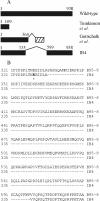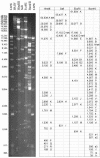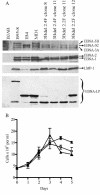Epstein-Barr virus with the latent infection nuclear antigen 3B completely deleted is still competent for B-cell growth transformation in vitro
- PMID: 15767450
- PMCID: PMC1061580
- DOI: 10.1128/JVI.79.7.4506-4509.2005
Epstein-Barr virus with the latent infection nuclear antigen 3B completely deleted is still competent for B-cell growth transformation in vitro
Abstract
The Epstein-Barr virus (EBV) nuclear antigen 3B (EBNA-3B) is considered nonessential for EBV-mediated B-cell growth transformation in vitro based on three virus isolates with EBNA-3B mutations. Two of these isolates could potentially express truncated EBNA-3B products, and, similarly, we now show that the third isolate, IB4, has a point mutation and in-frame deletion of 263 amino acids. In order to test whether a virus with EBNA-3B completely deleted can immortalize B-cell growth, we first cloned the EBV genome as a bacterial artificial chromosome (BAC) and showed that the BAC-derived virus was B-cell immortalization competent. Deletion of the entire EBNA-3B open reading frame from the EBV BAC had no adverse impact on growth of EBV-immortalized B cells, providing formal proof that EBNA-3B is not essential for EBV-mediated B-cell growth transformation in vitro.
Figures



Similar articles
-
EBNA-3B- and EBNA-3C-regulated cellular genes in Epstein-Barr virus-immortalized lymphoblastoid cell lines.J Virol. 2006 Oct;80(20):10139-50. doi: 10.1128/JVI.00854-06. J Virol. 2006. PMID: 17005691 Free PMC article.
-
Structural, functional, and genetic comparisons of Epstein-Barr virus nuclear antigen 3A, 3B, and 3C homologues encoded by the rhesus lymphocryptovirus.J Virol. 2000 Jul;74(13):5921-32. doi: 10.1128/jvi.74.13.5921-5932.2000. J Virol. 2000. PMID: 10846073 Free PMC article.
-
EBNA2 and Its Coactivator EBNA-LP.Curr Top Microbiol Immunol. 2015;391:35-59. doi: 10.1007/978-3-319-22834-1_2. Curr Top Microbiol Immunol. 2015. PMID: 26428371 Review.
-
Epstein-Barr virus nuclear protein 2 is a key determinant of lymphocyte transformation.Proc Natl Acad Sci U S A. 1989 Dec;86(23):9558-62. doi: 10.1073/pnas.86.23.9558. Proc Natl Acad Sci U S A. 1989. PMID: 2556717 Free PMC article.
-
Immortalizing genes of Epstein-Barr virus.Adv Virus Res. 1991;40:19-55. doi: 10.1016/s0065-3527(08)60276-6. Adv Virus Res. 1991. PMID: 1659776 Review.
Cited by
-
The EBNA3 family of Epstein-Barr virus nuclear proteins associates with the USP46/USP12 deubiquitination complexes to regulate lymphoblastoid cell line growth.PLoS Pathog. 2015 Apr 9;11(4):e1004822. doi: 10.1371/journal.ppat.1004822. eCollection 2015 Apr. PLoS Pathog. 2015. PMID: 25855980 Free PMC article.
-
Epstein-Barr virus nuclear protein EBNA3C residues critical for maintaining lymphoblastoid cell growth.Proc Natl Acad Sci U S A. 2009 Mar 17;106(11):4419-24. doi: 10.1073/pnas.0813134106. Epub 2009 Feb 23. Proc Natl Acad Sci U S A. 2009. PMID: 19237563 Free PMC article.
-
RUNX super-enhancer control through the Notch pathway by Epstein-Barr virus transcription factors regulates B cell growth.Nucleic Acids Res. 2016 Jun 2;44(10):4636-50. doi: 10.1093/nar/gkw085. Epub 2016 Feb 15. Nucleic Acids Res. 2016. PMID: 26883634 Free PMC article.
-
Infection and immune control of human oncogenic γ-herpesviruses in humanized mice.Philos Trans R Soc Lond B Biol Sci. 2019 May 27;374(1773):20180296. doi: 10.1098/rstb.2018.0296. Philos Trans R Soc Lond B Biol Sci. 2019. PMID: 30955487 Free PMC article. Review.
-
Cloning of the Epstein-Barr virus-related rhesus lymphocryptovirus as a bacterial artificial chromosome: a loss-of-function mutation of the rhBARF1 immune evasion gene.J Virol. 2011 Feb;85(3):1330-9. doi: 10.1128/JVI.01411-10. Epub 2010 Nov 17. J Virol. 2011. PMID: 21084476 Free PMC article.
References
Publication types
MeSH terms
Substances
Grants and funding
LinkOut - more resources
Full Text Sources

